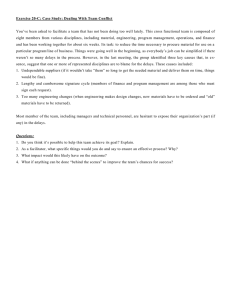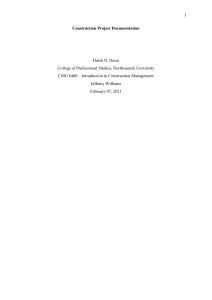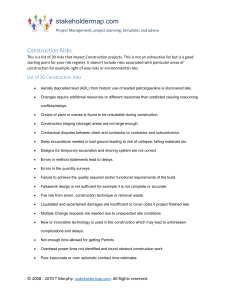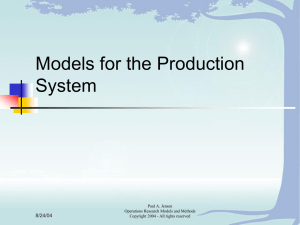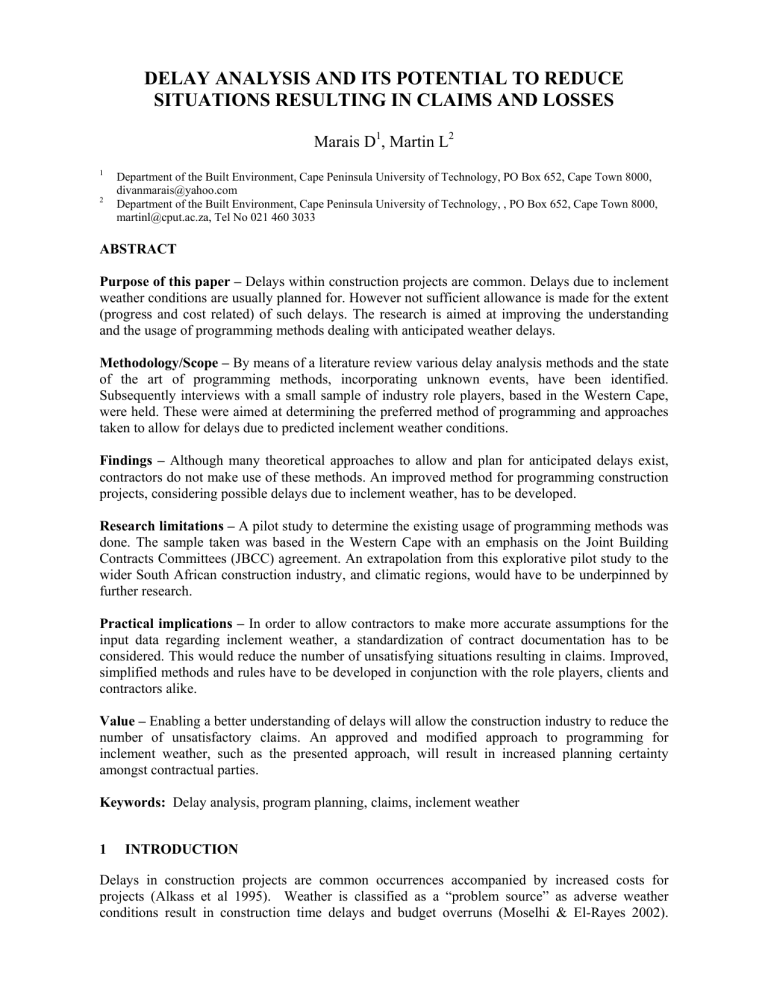
DELAY ANALYSIS AND ITS POTENTIAL TO REDUCE SITUATIONS RESULTING IN CLAIMS AND LOSSES Marais D1, Martin L2 1 2 Department of the Built Environment, Cape Peninsula University of Technology, PO Box 652, Cape Town 8000, divanmarais@yahoo.com Department of the Built Environment, Cape Peninsula University of Technology, , PO Box 652, Cape Town 8000, martinl@cput.ac.za, Tel No 021 460 3033 ABSTRACT Purpose of this paper – Delays within construction projects are common. Delays due to inclement weather conditions are usually planned for. However not sufficient allowance is made for the extent (progress and cost related) of such delays. The research is aimed at improving the understanding and the usage of programming methods dealing with anticipated weather delays. Methodology/Scope – By means of a literature review various delay analysis methods and the state of the art of programming methods, incorporating unknown events, have been identified. Subsequently interviews with a small sample of industry role players, based in the Western Cape, were held. These were aimed at determining the preferred method of programming and approaches taken to allow for delays due to predicted inclement weather conditions. Findings – Although many theoretical approaches to allow and plan for anticipated delays exist, contractors do not make use of these methods. An improved method for programming construction projects, considering possible delays due to inclement weather, has to be developed. Research limitations – A pilot study to determine the existing usage of programming methods was done. The sample taken was based in the Western Cape with an emphasis on the Joint Building Contracts Committees (JBCC) agreement. An extrapolation from this explorative pilot study to the wider South African construction industry, and climatic regions, would have to be underpinned by further research. Practical implications – In order to allow contractors to make more accurate assumptions for the input data regarding inclement weather, a standardization of contract documentation has to be considered. This would reduce the number of unsatisfying situations resulting in claims. Improved, simplified methods and rules have to be developed in conjunction with the role players, clients and contractors alike. Value – Enabling a better understanding of delays will allow the construction industry to reduce the number of unsatisfactory claims. An approved and modified approach to programming for inclement weather, such as the presented approach, will result in increased planning certainty amongst contractual parties. Keywords: Delay analysis, program planning, claims, inclement weather 1 INTRODUCTION Delays in construction projects are common occurrences accompanied by increased costs for projects (Alkass et al 1995). Weather is classified as a “problem source” as adverse weather conditions result in construction time delays and budget overruns (Moselhi & El-Rayes 2002). McDonald (2000) categorized weather as an “excusable non-compensable” delay. Generally delays falling within this category allow contractors to claim for extensions of time, however not for financial compensation for the cost impact thereof (Kartam 1999). The main construction contracts used within the South African building industry are following the same principal. An attempt to minimize the delaying effects of weather on building sites is the most common means of “compensating” for not being able to control weather. The main construction contracts used within South Africa require contractors to make allowance for normally expected weather conditions in their contract programme. This is done by means of weather contingencies built into the programme. The question of “what are normally expected weather conditions?” arises. Currently no structured or formal method to judge weather conditions and its effects on construction programmes exists. Contractors in the Cape Peninsula appear to make time related weather contingencies based on perceived risks. Chan & Au (2006) established that contractors seldom make provisions, in terms of cost, for the effects of inclement weather. The provisions made will rather depend on the contactors estimate of the anticipated risk on the project. Good client-contractor relationships are important to both parties for the success of a project and anticipated future work. Semple et al. (1994) found that making provisions in a construction programme for events such as weather delays reduces disputes. Cost and time claims, especially those which are difficult to quantify, regularly result in disputes between the contractual parties. Weather contingencies are very seldom adequate, in terms of progress and cost, due to the use of heterogeneous methods used in the industry for weather contingency calculations. This results in adverse client-contractor relationships. This research endeavour is aimed at improving the understanding and the usage of programming methods in dealing with anticipated weather delays, both progress and cost related. An improved method, which could be further developed for an uniform industry wide usage, can then be developed. 2 PROGRAMMING, SCHEDULING, DELAY ANALYSIS & WEATHER ALLOWANCES 2.1 Programming and scheduling Construction programmes are of utmost importance for a successful timely delivery of buildings or infrastructure projects. Accompanying these programmes the required resources have to be identified and managed accordingly. Various methods for scheduling projects are used. Yamin & Harmelink (2001) identified four planning techniques currently in use in the world wide construction industry, namely: Bar charts, Activity on arrow, Activity on node, and Line of balance (linear scheduling). The Activity on arrow and Activity on node techniques are also known as network scheduling techniques. The bar chart was developed in the 1900’s by Mr Henry L. Gantt and is the simplest of all scheduling techniques (Eggleston 1997). The bar chart consists of a horizontal (time) and a vertical (activity) axis. Each activity within a project is represented by a horizontal bar with its duration represented by the length of the bar. The logical sequence of the work, as decided by the planner, is indicated by lines linking the activity bars. The main advantage of the bar chart is its simple visualisation of a project and its activities. Yet in order to derive such visualisation the sole use of the bar chart technique tends to be unsuitable. Here the bar chart can be combined with network scheduling. This technique allows a better planning of interconnected and inter-depending activities. Stevens (1990) defined network scheduling as: “... a method of scheduling activities by joining them in a series of interconnected links which reflect relationships of activities as assigned by the planner” A critical path can be established by both of the above mentioned network scheduling techniques. The critical path determines the shortest time in which the construction work can be completed (Carnell 2000). Activities on the critical path have no float whereas activities not on the critical path have float. Float is the amount of time by which an activity can be delayed without delaying the anticipated end date of the project (Cormican 1985). The biggest shortfall of the bar chart is thus overcome by creating a bar chart through network scheduling, producing a visually strong programme with a critical path and floats determined by the interconnected links/relationships between activities. 2.2 Delay analysis techniques Delay analysis is merely applying the planning techniques used to plan the project all over again. There are various delay analysis techniques used. These include: the Global Impact Method, the Asplanned Method, the As-planned vs. as-built Schedule Analysis, the Modified as-built Method, the Impact as-planned Method, and the Collapsed as-built Method. These methods adopt a variety of different approaches to analyze the effect a delay has on the contract completion date. The most inaccurate method is the “Global impact method”. Here the sum of all the delay durations is regarded as the total project delay, irrespective if floats were used or not. The other techniques highlight many interesting, important and useful facts about a project. The critical path of a project continuously changes as the project proceeds. As the Critical path has no floats within the activities, a delay to an activity on the critical path causes a project delay. Some techniques do however ignore the critical path and/or the changing nature thereof. With the “Asplanned method” and the “impact as-planned method” delays are incorporated into the base programme in the form of “events with durations” (Gothand 2003) which is particularly suitable for weather delays and its consequential delays. The “as-planned vs. as-built technique” makes use of contract documents at project completion to identify and analyze delays on the project. The “modified as-built method” analyzes delays in pre-determined windows (time periods) with each delay being allocated to a responsible party (contractor, owner etc.) – making it a useful tool for claim adjudication. 2.3 Weather allowances Although there are currently various techniques by which the delaying effects of weather can be allowed for in a contract programme, anecdotal evidence suggests that these techniques deliver unsatisfactory results. According to McDonald (2000) the location of the project, the type of work, and the time of the year in which the work is to be executed plays an important role in quantifying the allowance to be made for weather in contract programmes. The latter is certainly the case for the Cape Peninsula with its varying weather conditions, with heavy rains in winter and dry windy summers. Harris (1978) cites Moder & Phillips (1970) who suggest two methods for including weather allowances in a contract programme. The first is to add one weather activity at the end of the project programme. The second is to predict which activities will be affected by weather and to increase their durations. These suggested methods however purely rely on the planner’s attitude towards and understanding of weather delays. Another method suggested by McDonald (2000) is to create a weather sensitive calendar which is incorporated into a scheduling software programme and linked to all weather sensitive activities. This method however ignores the weather sensitivity of each activity and the varying weather across a country, making it difficult to implement uniformly on a bigger scale. 3 CONTRACT LAW AND INCLEMENT WEATHER CLAIMS The four main construction contracts, as also recommended by the Construction Industry Development Board (CIDB 2004), used in the South African construction industry are the JBCC Principal building agreement, International Federation of Consulting Engineers (FIDIC), New Engineering Contract (NEC) and General Conditions of Contract for Works of Civil Engineering Construction (GCC). While the JBCC agreement makes no provision for the contractor having to prepare a contract programme, the GCC, FIDIC and NEC clearly state in clause 12.2, 8.3 and 31.1 respectively that the contractor is obligated to provide a realistic contract programme in line with the planning and scheduling techniques discussed earlier. The FIDIC document further requires the contractor to inform the engineer of future events, such as weather, which could affect the works. The NEC gives the engineer the authority to reject a programme should he/she feel it is unrealistic. With regards to claiming for weather delays, the JBCC allows for an extension of time for a delay caused by “inclement weather” but does not allow for a financial compensation, such as Preliminaries & General (P&G) claims. The GCC makes provision for a reasonable time extension for delays due to “abnormal climatic conditions” plus financial compensation for time-related general items (P&G). FIDIC allows for an extension of time but no financial compensation for “exceptional adverse climatic conditions”. The NEC makes provision for an extension of time for certain compensation events. Here inclement weather occurring less than once every 10 years qualifies for being such a compensation event. It is evident that the four main contracts require the contractor to make reasonable allowance for weather delays in contract programmes, as extensions of time are usually only granted for abnormal weather conditions. Financial compensation for weather related delays is only granted when using the GCC form of contract. 4 RESEARCH METHODOLOGY A desktop research and literature review were conducted. The aim was to identify the state of the art in programming and scheduling techniques, delay analysis techniques and methods of incorporating unknown events in contract programmes – as also discussed above. This formed the base for a later investigation of current practices within the industry by means of a pilot study like set-up. The small pilot study was conducted by means of interviews, combined with site visits, with a small sample of industry role players representing the bigger contractors within the Cape Peninsula. For the pilot study three of the major contractors were approached. An emphasis was placed on the building sector and the JBCC agreement as opposed to the engineering, civil sector of the industry. The interviews aimed to determine the preferred method of programming and delay analysis in the industry. Further the approaches taken for the prediction of inclement weather conditions and of their effects on differing building sites were explored. The interviews were semi-structured in nature. A broad outline of the interview and questions were e-mailed or faxed to the interviewees in advance. The interviews were recorded, transcribed, and thereafter analyzed and cross-checked with each other. Based on the review and the fieldwork some suggestions for an improved method for drawing up transparent contract programmes, taking inclement weather delays into account, are made. 5 SUMMARY OF FIELDWORK AND FINDINGS 5.1 Effects of weather on building construction sites Commonly mentioned by the interviewees, the critical path of a project would usually run through the earthworks, structure, wet trades and internal finishes. The magnitude of the delaying effect of weather largely depends on the intensity of the weather occurrence, the characteristics of the site (surrounding buildings, drainage characteristics etc.), and the type of construction operation. For example, a certain amount of rainfall will result in a greater delay during earthworks (with consequential delays) than with internal finishes. Likewise, wind of 40km/h will have a greater delaying effect on crane dependent operations than on operations not dependent on crane time. Weather conditions also affect the productivity of equipment and labour. It determines which building activities can take place and usually also impacts on safety measures to be taken at the time. The consent of the interviewees was that each site must be viewed as an individual “entity” based on the unique characteristics of the structure to be erected, its location, its surroundings and the expected weather conditions in that area. This is in accordance with findings of McDonald (2000). The loss in equipment and labour productivity and more stringent safety requirements have to be taken into account. 5.2 Contract review The JBCC principal building agreement is used on the majority of the building projects tendered on in Cape Peninsula. The results of the interviews reflect the findings from the literature review with regards to weather related delays in terms of the JBCC (i.e. extension of time but no financial compensation). In most cases reported on, the wording of the standard weather clause of the JBCC agreement (Clause 29.1.1) is changed from “inclement weather” to “exceptional inclement weather” forcing the contractor to make some allowance for normally anticipated weather related delays. With this change in wording the professional quantity surveyors usually state, as part of the Bill of Quantities, the allowance a contractor must make in his programme in terms of weather delay days. This retains the competitive nature of the tendering process with predetermined risks to be considered. In practice this allowance is however not always found to be accurate and the contractor mostly has the option of qualifying his tender on the original contract wording or any alternative wording. Yet, the freedom to change this contract clause wording, and the qualifying of tenders were identified as contributors to the inaccuracy of weather “contingencies” in contract programmes – with its potential for disputes. 5.3 Programming and scheduling Many contractors make use of the “Site plan” module of the CCS (Construction Computer Software) Candy and MS Project software programmes which are based on the bar chart and network analysis techniques. During the pilot study it emerged that the most important factor planners focus on during the planning of a project, is to ensure that the logic sequences within the project is correct and sound; and secondly that the durations of the activities are as accurate and realistic as possible. According to planners, the most risk lies in the logic of the programme rather than in inaccurate activity durations. Many assumptions are made during tender planning. This is due to limited information provided creating some degree of uncertainty in activity durations. Evidence of the problem of uncertainty in activity durations were also found in the literature (e.g. Hendrickson 2003). Based mostly on their experience, contract planners have developed numerous ways in overcoming this uncertainty. The two main factors thus contributing to the accuracy of any programme are therefore the programming knowledge of planners and the extent of the information provided at tender stage. 5.4 Delay analysis According to the interviewed industry professionals (senior planners), an accurate and realistic contract programme in itself is the best delay analysis tool. The focus tends to be on the critical path activities during such delay analysis. It is generally assumed that any delay to a critical activity results in a delay to the contract completion equalling in duration to the initial delay experienced. This view expressed by the interviewees ignores the possibility of a delay changing a non-critical activity into a critical activity once all float has been consumed. It also might indicate the level of understanding of construction professionals of the process of the delay analysis per se. Focusing on delays to critical activities is the preferred approach by the interviewees, as opposed to extending the duration of all affected activities. It must however be noted that the latter is a time consuming and expensive process. 5.5 Incorporating unknown events (weather) into contract programmes Contractors generally act in accordance with the tender documentation with regards to weather contingencies. However varying points of view and interpretations on this matter exist amongst contractors, clients and quantity surveyors. The provision of contingencies for weather depends on the state of the industry (availability of work), the weather allowance stated in the Bill of Quantities and/or the timing and quantity of weather delays experienced on previous contracts. Even though guides are given in contract documents, contractors often qualify their tenders on their own weather contingency. Often no contingency at all are qualified in which case all delays over and above the stipulated allowance warrants an extension of time. This is also reflected in findings from Chan & Au (2007) derived from a survey amongst Hong Kong contractors. A similar approach for claims due to consequential weather delays is adopted. However, a fair assessment of this kind of delays is crucial in order to settle such claims; an undertaking with its inbred difficulties. Historical records are available from which valuable information can be obtained for the calculation of the timing and quantity of any weather contingencies. This method is however uneconomical for contractors as it requires technical and time consuming calculations when accommodating these weather events in the contract programmes. Contractors currently use four methods of allowing for weather delays in contract programmes: Adding a weather activity at the end of the programme, as also suggested by Moder & Philips (1970); Adding non working days into the calendar of the software programme, similar to McDonalds (2000) approach; Lengthen the duration of critical activities; and Crash and Re-analyze critical activities after the contract has been awarded to shorten the actual contract duration. Even with all these methods of creating weather contingencies in programmes, the ultimate decision on the contract duration lies with senior management using a base programme, which is indicative at best. 6 DEVELOPMENT OF AN IMPROVED METHOD Based on the desktop research and the findings from the fieldwork a first step towards an improved method of dealing with weather delays in a more transparent manner is taken. The improved method consists of two elements. The first being the accurate calculation of input data (timing and quantity of anticipated weather related delays) and the other being the method whereby the input data is transparently incorporated into the contract programme. In order to achieve a high acceptance within industry an improved method should be based on the preferred software programme (CCS – linked bar chart), should be visually clear, easy to understand and interpret, and show logical links between activities. Guidelines with regards to input data should be developed. These should be specific, clear and unambiguous. It should guide the contractor in a precise manner in determining how wind, rain and safety as a result of weather could delay each activity of a project. Due to the technical nature of the subject, expertise and time involved in converting historical site and weather data into such input data, and also the need for uniformity required for each contract, such guidelines for calculating the input data should be developed by the JBCC. This body represents the important industry role players and such guideline should be made part of the JBCC series, thus getting the commitment of contractual parties to use such guidelines. The overall guidelines, affecting not only programming but also contract law, will have to be underpinned by further comprehensive research. An improved method should treat each activity on its own merit and should take the following activities and characteristic of the site into consideration: Timing of the activity (time of the year) Geographic and physical location of the site Position of the site relative to the surrounding buildings and areas Soil characteristic of the site and the accompanied drainage characteristics of the site Stage of construction Changes in the productivity of labour and equipment as a result of weather Intensity of the weather anticipated Effect of weather events experienced simultaneously (wind and rain at the same time), and the State of the industry. An improved method of incorporating the calculated input data into the contract programme could be based on the principals of the “as-planned schedule analysis” technique whereby delays are represented by activities with durations. Each activity in the work breakdown structure of the project should be represented by a minimum of one bar chart bar and a maximum of four bar chart bars. The minimum of one bar is the estimated duration of the activity itself. The other three bars would be successors of the “duration” bar with finish to start relationships and would include any of the following (see also Figure 1): Wind delay bar – represents the expected extent to which wind will delay the activity Rain delay bar – ditto but with regards to rain Safety delay bar – ditto but with regards to wind and rain induced safety delays Figure 1: Visual image of concept for improved method Only the weather delays expected to affect the specific activity should be considered in such guidelines. The delay bars mentioned above should include re-work delays and consequential delays. Should the updated contract programme show a contract duration longer than that stipulated in the tender documents, resources on the critical path should be adjusted to shorten their durations. Unused weather contingencies will create weather float which is for exclusive use for weather delays. Here both the client and the contractor could agree on something else if such float becomes available. For the improved method to be successful, the client should not have the power to change the wording of the weather clause(s) of the chosen contract form. The contractor may not qualify his tender with his own weather “conditions”. The wording of the weather related contract clauses should thus be revised and drafted in line with the input data guidelines and the improved method, reducing weather related claims. However it must be said that this could impede on the contractual freedom enjoyed by contract parties. 7 CONCLUSION Construction contracts make provision for contractors to claim for an extension of time for abnormal weather conditions. Yet no financial compensation is granted for cost due to such delays. The financial risk thus rests with the contractor. Most standard contract documents require contractors to produce a programme of the works. The programme is an important tool for contractors to monitor the progress and plan for known and unknown events thereby reducing his overall risk. In order to make sufficient allowance in contract programmes for weather related delays, accurate input data is required. The method of incorporating this input data into the programme is also crucial for a risk conscious approach to weather delays and the control thereof. Many techniques exist in which the input data is calculated. Yet all these often produce unsatisfactory results. To add to the problem, clients can change the standard wording of contract clauses and contractors are at liberty to manipulate the programme and qualify tenders. Giving guidelines on input data to contractors, as part of the tender documents, would ensure uniformity in tender programmes. Due to the complicated nature of weather events, the accuracy desired from programmes resulting in better management of weather are difficult to achieve. The use of historic data could be a good approach to schedule for unknown events. This needs to be combined with a consideration of the unique characteristics of a particular contract, which in return requires a highly technical and time consuming analysis of projects. The preferred method for planning building work in the Cape Peninsula is the bar chart created from a network analysis. A characteristic of this programming method is the determination of the critical path of the project. It is important to note that the critical path will continuously changed during project execution and all activities must therefore be treated as critical when making provision for weather delays in contract programmes. Incorporating the calculated input data into contract programmes is similar to applying delay analysis methods at tender stage. Although many techniques exist, the best results are obtained from techniques based on the linked bar chart where delays are represented by bars (activities) with durations. A guideline for dealing with the allowance for weather delays should be developed. Such improved method should be promoted throughout the industry in order to become an industry norm. An improved method should consider all activities of a project. A clear allocation of expected and allowed delays should be made. The allocation of these allowances, by means of additional activity related delay bars, will make programmes more transparent. An improved method would thus reduce risks on projects, improve project monitoring and control, reduce conflict and disputes due to claims regarding weather delays on building construction projects, and promote planning certainty amongst all contractual parties. 8 REFERENCES Alkass, S., Mazerolle., Tribaldos, E., and Harris, F. 1995. Computer aided construction delay analysis and claims preperations. Journal of Construction Management and Economics, 13(4), 335-352. Carnell, N. J. 2000. Causation and delay in construction disputes. Oxford: Blackwell science Ltd. Chan,E.H.W., and Au, M.C.Y. 2006. Building contractors’ behavioural pattern in pricing weather risk. International Journal of Project Management, 25(6), 615-626, January. CIDB, 2004. Best Practice Guide #C2 – Choosing an appropriate form of contract for engineering and construction works. Pretoria, CIDB, March. Cormican, D. 1985. Construction Management: Planning & Finance. New York: Longman Inc. Eggleston, B. 1997. Liquidated damages & extensions of time in construction contracts. Tokyo: Blackwell Science Ltd. Gothand, K.D. 2003. Schedule delay analysis: modified windows approach. Cost Engineering, 45(9) 18-23, September. Harris, R.B. 1978. Precedence & arrow networking techniques for construction. Canada: John Wiley & sons Inc. Hendrickson. C. 2003. Project management for construction. Carnegie Mellon University. http://www.ce.cmu.edu/pmbook/09_Construction_Planning.html [19 Nov 2007]. Kartam, S. 1999. Generic methodology for analyzing delay claims. Journal of Construction Engineering and Management, 125 (6), 409-419, November/December. McDonald, F.D. 2000. Weather delays and impacts. Cost Engineering, 42(5), 34-39, May. Moder, J.J. and Phillips, C.R. 1970. Project management with CPM and PERT. 2nd ed. New York: Van Nostrand Reinhold Co. Moselhi, O. & El-Rayes, K. 2002. Analysing weather-related construction claims. Cost Engineering, 44(8), 12-19, August. Semple, C., Harman, T.T. & Jergeas, G. 1994. Construction claims and disputes: Causes and cost/time overruns. Journal of Construction Engineering and Management, 120(4), 785-795, December. Stevens, J.D. 1990. Techniques for construction network schedules. USA: McGraw-Hill Inc. Yamin, R.A. & Harmelink, D.J. 2001. Comparison of linear scheduling model (LSM) and critical path method (CPM). Journal of Construction Engineering and Management, 127(5), 374-381, September/October.
